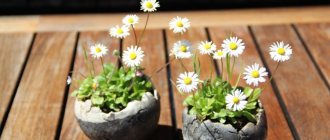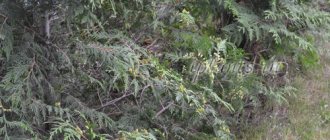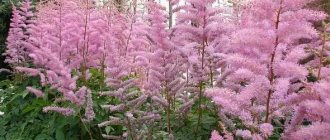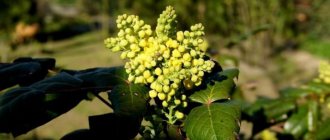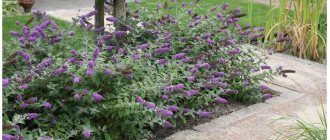Home » Flowers and plants » Outdoor plants » ? Perennials
Fedurina Nadezhda 05/13/2020
6887 Views
Lush astilbe bushes will decorate your garden plot. They are actively used in landscape design. Planting and care are simple, accessible even to beginners in floriculture.
Description
Astilbe belongs to the Saxifraga family . The genus includes approximately 40 species, consisting of 400 varieties. Of the entire variety, only about 40 pieces were distributed.
Under natural conditions it grows in North America, Japan, and East Asia. You can meet it in lowlands, near rivers, and in deciduous forests. The plant loves moist soils.
By type, astilbe is a rhizomatous plant.
The roots are woody. New buds form on them every year, the old part slowly dies off.
Its stems are erect. They grow from 10 cm to 2 m . Their life cycle lasts from spring to autumn.
Astilbe leaves grow on long petioles. Their plates are cut twice or thrice. There are teeth along the edges. They are painted dark green, some varieties may have a reddish tint.
The inflorescence is represented by panicles that grow up to 60 cm long. They consist of small flowers. Their color can be white, pink, red, purple.
The flowering period occurs in the summer months. It lasts about 14 days. After it, the fruit-box with seeds ripens.
After flowering
In autumn, when the astilbe flowers are already half dried, the plant continues to be a decoration of the garden. When the flowering season comes to an end, preparation of the astilbe for wintering begins, order is restored - the stems are cut right down to the soil and mulched on top.
You can divide the bushes at the roots. Such a transplant will rejuvenate the plant. As long as the root is not woody, it is easy to separate.
The main thing is to monitor the presence of growth buds and protect the roots from frost. Then, in a year, the transplanted astilbe will delight you with its lush, beautiful flowering.
Kinds
Types of Astilbe
Scientists use several classifications of astilbe: by origin, by name, by color of inflorescences, flowering period, height of bushes, and others.
Height classification:
- Dwarf, up to 30 cm
- Low, up to 60 cm
- Medium, up to 90 cm
- High up to 2 m
Classification by inflorescences:
- Diamond-shaped
- paniculata
- Pyramid
- Drooping
Classification by flowering period:
- Early
- Average
- Late
Let us dwell in more detail on the classification by origin. It is accepted by botanists as a basis.
Arends
Astilbe Amethyst
Arends
- Unites 40 varieties . They are represented by perennial plants with a powerful, branched root system. The bushes grow up to 1 m in height, the cross section is 70 cm. The crown is either pyramidal or spherical. The leaves are pinnate, green with a glossy sheen.
- Hybrids of this series are obtained by crossing David's astilbe with other varieties.
- The group is characterized by a long flowering period, up to 40 days. It falls in the second half of summer.
The series includes varieties such as:
| Name | Bush height | Inflorescence shape | Inflorescence color | Flowering period | Flowering time |
| Amethyst | 80 cm | Paniculate | Light lilac | July | 25-30 days |
| White Gloria | 80 cm | Diamond-shaped | Lilac | July | 25-30 days |
| Brautschleier | 70-80 cm | drooping | Yellowish white | First half of July | 16 days |
| gluten | 70-80 cm | Paniculate | Reds | August | 15-20 days |
| Diamond | 90 cm | Paniculate | White | July | 25-30 days |
| Anita Pfeiffer | 60-80 cm | Paniculate | Salmon Pink | July | 30 days |
| Erika | 85-90 cm | Rhombic | Light pink | Second decade of July | 14 days |
| Hyacinth | 80-90cm | Rhombic | Light lilac | Second decade of July | 14 days |
| Ruby | 80 cm | Paniculate | Lilac | July August | 18-25 days |
| Bressingham beauty | 80-100 cm | Paniculate | Hot pink | July August | 30 days |
| Gloria Porpurea | 70 cm | Paniculate | Dark lilac-pink | July August | 20-30 days |
Astilbaudies
Astilbe Blond
Astilbaudies
- The group includes 3 varieties bred by E. Lemoine: Blondin, Keningin Wilhelmina, Lord Salsbury and 1 variety - M. Desbois: Floribunda.
- Their height is 60-90 cm. The leaves are large, twice dissected. Their color is light green. The veins on the leaves are covered with hairs on both sides.
- The flowers are white or pink, forming a pyramidal inflorescence. It is 45 cm long and 20 cm wide. The side branches are drooping. Flowers have 10 stamens.
- The flowering period occurs in June – July.
- Withstands frost down to -23 degrees. In regions with colder winters, shelter is required.
- These varieties are rarely found in flower beds. It is almost impossible to find them on sale. These varieties formed the basis of new varieties.
Low hybrids of Chinese astilbe
Astilbe Serenade
Low hybrids of Chinese astilbe
- Representatives of this group are distinguished by a late flowering period. They bloom their flowers in August–September.
- The group of Chinese hybrids includes a variety used in breeding, which is the basis of the Arends series - David's astilbe. It has powerful, tall bushes - 150-200 cm. The stems are red-green in color.
- The leaves have a bronze tint when they bloom in spring, later becoming light green. The color of the paniculate inflorescences is lilac-pink or fuchsia.
- Flowering lasts 14 days in July.
The table shows the popular varieties of this series:
| Bush height | Inflorescence shape | Inflorescence color | Frost resistance | Flowering time | |
| The final | 40 cm | paniculata | Pink | -25 | 25 days |
| Intermezzo | 60 cm | paniculata | Salmon pink | -25 | 25-30 days |
| Serenade | 100 cm | paniculata | Lilac pink | -30 | 25 days |
| Veronica Kloz | 40 cm | paniculata | Dark pink | -27 | 25-30 days |
| Purpurkertz | 100 cm | paniculata | Purple pink | -25-30 | 30 days |
| Spatsommer | 40 cm | Spica-shaped | Pink | -30 | 30 days |
Fringed hybrid
Astilbe Liliput
Fringed hybrid The group consists of Arends varieties. Their difference is in the openwork, highly feathery leaves. These varieties are distinguished by very decorative inflorescences and graceful shapes. Common varieties:
- Dagalet - with the onset of autumn, the leaves turn bronze. Blooms with cream flowers.
- Lilliput is a dwarf variety with salmon-pink flowers.
- Perkeo is a compact plant, no more than 20 cm high. Pink or purple flowers form narrow pyramidal inflorescences. It blooms in the first half of July, a little more than two weeks. The leaves have a bronze tint in spring.
- Peter Pan - has bright pink pyramidal inflorescences
Hybrid varieties
Astilbe America
Hybrid varieties
- The group includes approximately 50 varieties. It is one of the most numerous.
- This includes all astilbes that cannot be classified into other groups.
Let's look at a few of the most famous flower growers:
| Name | Bush height | Inflorescence shape | Inflorescence color | Flowering period | Flowering time |
| America | 70 cm | paniculata | Light pink | July | 18 days |
| Avalanche | 60 cm | drooping | White | July | 20 days |
| Rubella | 90 cm | paniculata | Light purple | July | 14 days |
| Kwele | 60-80 cm | paniculata | Lilac-pink | July | 20 days |
Japanese hybrids
Astilbe Bremen
Japanese hybrids Low bushes grow up to 90 cm. They have shiny leaves. The bushes are very spreading with a large number of side shoots. Basically all flowers bloom early. Representatives of this group are used for forcing.
Description of some varieties:
- Bremen bushes grow up to 50 cm. Raspberry inflorescences have a pyramidal shape. The flowering period occurs in July – August.
- Gladstone grows up to 50 cm. The inflorescences are creamy-white, drooping. Flowers bloom in July.
- Montgomery blooms in late summer. The inflorescences consist of large red flowers. Its bushes grow up to 70 cm.
- Plume has drooping inflorescences, colored cream or light pink. The height of the bush is 80 cm.
Lemoine hybrids
Astilbe Mont Blanc
Lemoine hybrids
- This series includes about 20 varieties.
The most common:
| Name | Bush height | Inflorescence shape | Inflorescence color | Flowering period | Flowering time |
| Gerbe de Neige | 95 cm | Drooping, up to 50 cm long | Cream | July | 25-30 days |
| Mont Blanc | 60 cm | Pyramid | White | End of July-August | 20 days |
| Plume Neijo | 80 cm | Drooping | White with a pinkish tint | July | 18 days |
Pink hybrids
Astilbe Queen Alexandra
Pink hybrids This group includes 2 varieties:
- Peach Blossom - distinguished by spreading bushes, the height of which is about 60 cm. Paniculate inflorescences are 10-25 cm long. They are painted in a light lilac color. They bloom for about 15 days in July. The frost resistance of the variety is high.
- Queen Alexandra - the height of the bush is 60 cm. The color is soft pink. Flowers are collected in paniculate inflorescences.
Simple leaf hybrids
Astilbe Aphrodite
Simple-leaved hybrids The group consists of 16 varieties. The main thing is that their difference is simple, not openwork, leaves. The bushes do not exceed 50 cm in height. These hybrids do not tolerate hot weather very well and are suitable for regions with cool weather in summer. It is better to plant them in the shade.
Common varieties:
- Aphrodite is a dwarf variety, the height of its bush is on average 40 cm. The color of the inflorescences is crimson.
- Bronze Elegance grows up to 30 cm. Drooping inflorescences are pale pink.
Astilbe Take
Astilbe Superba
Astilbe Take
- The group is small . The most famous variety included in it is Superba. Its bush is 1 m tall. The panicle inflorescences are colored lilac-pink. It belongs to the varieties of late flowering, it occurs in August, for 25 - 30 days.
- The variety is frost-resistant . Withstands temperatures down to -30 degrees.
Astilbe Thunberg
Astilbe van der Willen
Astilbe Thunberg The group includes varieties that were bred by G. Arende and B. Reis. The inflorescences of these hybrids reach a length of 25 cm. The flowers of the series smell pleasant. These varieties have rather low frost resistance; they must be covered for the winter.
- Betsy Kuperos is a rather tall bush, its height is 120 cm. The flowers form light pink panicle inflorescences. They bloom in August.
- Professor van der Willen - grows up to 90 cm. The color of the leaves in spring is brownish-green. The inflorescence is drooping, about 40 cm long. The color can be white or yellowish-white. It blooms in July for 15 to 20 days.
- Straussenfeder is distinguished by tall bushes up to 180 cm. Dark pink inflorescences have a drooping shape. It blooms for 20 days in July–August. The variety tolerates frosty weather well.
Naked hybrids
Astilbe Sprite
Naked hybrid cultivars are native to southern Japan. They cannot tolerate frost . Maximum frost resistance up to -23 degrees. All varieties of this group are dwarf, height is from 15 to 30 cm. Suitable for forcing.
The flowers are collected in panicles, with a loose structure. The flowering period coincides with mid-summer.
These include varieties:
- Sprite - grows in rounded bushes with a lot of branches. Their height is up to 50 cm. The inflorescence is represented by drooping panicles. They consist of small pink flowers.
- Saxatile is a low plant, 8-15 cm tall. Their root system has many suckers. Flowers form panicle inflorescences. Their color is lilac-pink. The bush produces few inflorescences; they are loose and scanty.
Astilbe propagation
Astilbe can be propagated by three methods:
- Seeds
- Kidneys
- Dividing the bush
Seed propagation method
Astilbe, which grows in gardens, is a representative of hybrid varieties . It was created by crossing by professional breeders. Special technologies are involved in this process.
Seeds collected from your own bush or from friends will lose their decorative qualities. They have poor germination. Those specimens that sprout will not have the qualities of the mother plant. Not only the brightness of their flowers, but also their leaves may change. They will be weak and susceptible to negative environmental factors.
Astilbe seeds
The best choice of seeds will be those provided by a reliable, trusted manufacturer. When you can’t buy the species you like, you can take a risk and plant your own. Astilbe seeds are not easy to collect because they are very small. 20 thousand grains weigh only 1 gram.
Several rules must be followed:
- Ripening occurs in September; it makes no sense to collect them earlier
- Faded inflorescences are cut off and laid out on sheets of paper
- Ripening lasts 2 weeks in a warm place
- When the panicles are completely dry, they need to be shaken. The seeds will spill onto the paper
- Planting is done in spring
Before sowing seeds into the soil, they must be subjected to a stratification procedure:
- Place the seeds on a damp piece of cloth
- For greater effect, it is recommended to mix them with sand, peat, or layer them with cotton wool.
- Wrap the fabric and place it in a plastic bag
- Maintain at a temperature of 0+5 degrees. You can do this by placing them in the refrigerator door.
- Stratification of astilbe seeds can take up to six months
Store-bought seeds are also cooled. It takes them a few days to do this.
After the seeds sprout, they can be planted in containers filled with soil. The ideal substrate would be a mixture of sand, peat and leaf soil, proportion 1:1:2.
The sown seedlings are kept indoors at a temperature of +18+20 degrees. The first shoots will appear in about 15-20 days. They are white and covered with hairs.
Astilbe
Planting in open ground is carried out after the formation of the first full-fledged leaves . The planting site should be shaded so that direct rays of the sun do not burn the young plants. Astilbe does not tolerate drought . Both adult plants and seedlings need regular watering.
Bushes grown from seeds bloom after 3 years. This method is the longest.
Reproduction by buds
Separation by buds is recognized as the most effective way to propagate astilbe. It is held in the spring. The bushes get sick less, their survival rate increases. They begin to bloom earlier than those planted with seeds.
The process is root division . Each root cutting should have several renewal buds. Sections must be treated with ash.
The cuttings are planted in a greenhouse . The soil should consist of gravel and peat, the proportion is 1:3, respectively. The depth of the planting hole must correspond to the size of the planting material. The soil should completely cover the buds by 0.5 cm.
Astilbes in natural conditions
The plant takes root within a year . After this, in the spring it can be planted in a permanent place in open ground. It is possible to plant it immediately in the place where astilbe is planned to grow continuously. Then it is necessary to mulch the planting. It is covered with film on top.
When choosing such a planting, you need to fill the dug hole with the prepared soil mixture. Insulation is carried out for the winter. The bed is filled with peat mixed with sawdust and covered with film, spruce branches or other insulation.
After budding, you need to monitor temperature and humidity . In the cold it will begin to rot, which will lead to the death of the plant. There is no way to save her.
Dividing the bush
The third method of propagation is dividing the bush. The method is effective and popular. Thanks to it, the divided plant gets sick less and begins to bloom faster.
Schematic illustration
The advantage of propagation by dividing the bush is that it can be carried out at any time, even during the period of active flowering.
Step-by-step instruction:
- First of all, the bush is completely dug up
- Divide it into parts, each containing at least 4 renewal buds. The extra ones can be removed
- It is enough to leave 5 cm from the root. If there are dry areas, you need to trim them. The size of the rhizome does not matter. The bush is taking root well
- When planting, the distance between bushes should be at least 30 cm
- Be sure to water the planted astilbe
When dividing the bush in the spring, in the fall it will delight with blooming flowers.
Astilbe flower - cultivation and care
Lush flowering, shade tolerance, ease of care - these are the main advantages of the charming astilbe. Its beautiful bush with panicle inflorescences can decorate any area. Let's talk about how to grow it. To do this, you need to understand what requirements the plant makes for its development.
Astilbe loves moisture and can even tolerate slight flooding, but prolonged drought can be disastrous. It is necessary to constantly moisten the soil under it, especially in dry weather. The plant is not acidophilic, so it does not have any special requirements for soil acidity, but prefers a pH level of 5.5-6.5.
The root system has an unusual structure, growing over time, it grows upward and appears above the surface of the earth. Because of this, the bush can freeze in frosty winters and quickly dries out in summer. The root system does not grow deeper than 20-25 cm, because of this it cannot obtain moisture from the deep layers of the soil. Therefore, one of the best recommendations is to mulch the soil around the trunk well; this will help retain moisture in the summer and provide additional insulation in the winter.
Astilbe loves fertile soil. Therefore, in the spring, as well as in the first half of summer, the plant must be fed twice with mullein infusion or mineral nitrogen-containing fertilizers after watering or rain. Monthly fertilizing with vermicompost gives good results.
After flowering, it is recommended to trim the inflorescences so that the plants do not waste energy on setting seeds if you do not plan to collect them. It is recommended to feed the plant itself with phosphorus-potassium fertilizers, this will increase the winter hardiness of the plants. Astilbe is propagated by seeds or by dividing the bush. Division must be carried out every 4-5 years, otherwise the middle of the plant will die. The best time for this is early spring or already in August.
When dividing, the bush is dug up, then cut into sections with a sharp shovel or knife so that each has from 1 to 5 renewal buds. Plant the cuttings immediately so that the roots do not have time to dry out. At the same time, they are planted shallowly, but the distance between them should be at least 40-50 cm, since the bushes grow quite quickly. At the same time, humus or compost is placed in the planting holes, and half a glass of ash and 1-2 tablespoons of superphosphate are added. After planting, be sure to water thoroughly.
The above-ground part of the plant dies off in the fall, and shoots from the roots begin to grow every spring. Therefore, astilbe is cut off after the onset of the first frosts almost at the root and covered with a layer of mulch 5-10 cm thick on top. High-moor peat, rotted manure, and humus are used as mulch.
Landing rules
The development of a plant depends on the place where it grows. It is necessary to select comfortable conditions for everyone. This is the key to the success of beautiful and healthy astilbe bushes.
Selecting a location
Astilbe loves warmth, but it is better for it to grow in partial shade, in rarefied light . Bushes growing in sunny areas bloom less. The color of the inflorescences becomes much paler.
Flowerbed with astilbes
There are sun-loving varieties, but they are few. They differ in early or late flowering. The same species that bloom in mid-summer are recommended to be planted in the shade.
The soil
The plant can grow on any soil. If possible, you need to choose places with groundwater close to the surface.
Astilbes near a pond
Preparing the soil for planting:
- Before planting, the selected location must be dug up.
- Remove roots of other plants from the ground.
- Add humus or peat. 2 buckets are poured per square meter.
- The top layer of soil should contain potassium and phosphorus. To do this, add inert meal or complex mineral fertilizer. 30 - 50 grams per square meter is enough.
Astilbe is not recommended to be planted near trees with shallow roots. They will fight for incoming moisture. The fight will end unfavorably for the flower.
Landing
It is best to plant astilbe in the fall.
The air temperature should be kept from 5 degrees Celsius and above. The distance between bushes should be 30 cm for dwarf and low varieties, and 50 cm for medium and tall ones.
Step-by-step instruction:
- Dig a hole to a depth of 30 cm.
- Add fertilizer and water.
- Plant an astilbe bush.
- Cover the top with mulch. The layer must be at least 3 cm.
In the first year after planting, astilbe gains color. Experienced flower growers recommend cutting off the buds. A fragile plant will give all its strength to the inflorescences and may die.
Bedding
At the end of spring, beginning of summer, the dived young individuals are directly planted. The preferred location is the north side of the house, the presence of shade created by trees and large bushes.
Some varieties can be planted on the sunny side. Then the flowering will be abundant, but not long-lasting. Ideally, there should be a nearby body of water, a fountain, or a swimming pool. Soil moisture is an important condition necessary for growing astilbe.
Before planting, dig up the area, remove weed roots, and saturate the soil with useful, necessary microelements. Humus, peat, and ash can be used as fertilizer.
Astilbe is planted in shallow holes at a short distance, while the rhizome is placed so that the growth buds are covered on top with a small layer of soil (up to 5 cm). The top is mulched with humus and peat.
Care
Caring for astilbe bushes is easy. The main thing is to follow the basic rules.
Watering
Astilbe is moisture-loving. She needs to ensure a sufficient supply of water, so watering must be regular.
Do not allow the soil to dry out
Even a minimal lack of moisture has a detrimental effect on the plant. It becomes sluggish, the flowers fade. It very quickly becomes sloppy in appearance and withers.
Weeding
Thanks to its powerful root system, astilbe drowns out weeds. Young bushes need to be weeded. After the rain, the sprouted grass comes out.
The soil needs to be loosened. A crust should not be allowed to form on it. By the way, if the plant is mulched, then weeding and loosening is not required.
Application of decorative mulch
Peat mulch protects the root system well . Moreover, it prolongs the youth of astilbe by the fact that the renewal buds are constantly covered with a layer of soil.
Fertilizers
Astilbe near an artificial pond
Bushes are fed every year. The choice of fertilizer depends on the quality of the soil:
- If astilbe grows in moist soil, then it is fed with complex mineral fertilizers.
- When the plant is planted in dry soil, compost and peat are used.
Organic fertilizers make the foliage more lush and juicy. To do this, water the bushes with diluted manure. If you want to extend the flowering period, you need to feed it in the summer with a mixture of urea and superphosphate.
Transfer
Astilbe has a maximum lifespan of 20 years. At the same time, it is recommended to replant it every 5 years . Provided regular mulching, the procedure can be carried out after 7 years.
The transplantation procedure rejuvenates the plant and extends its life.
Bushes can be replanted in the spring before buds open and in the fall after flowering. The dug up plant can be replanted as a whole, or it can be divided into several parts. This process is described above in the section on reproduction by division.
After transplanting, the soil must be compacted and watered. This promotes survival.
Astilbe's neighbors
Astilbe gets along well with other plants. This allows you to select the neighborhood to suit your taste, creating beautiful landscape compositions. It is often planted on rocky soils, rock gardens, and near ponds.
Astilbes in landscape design
The openwork foliage of astilbe goes very well with hellebore bushes. Tulips, lilies of the valley, and irises planted nearby look beautiful.
Astilbe: combination with other plants
Growing astilbe in group plantings with other plants is quite justified. Decorative panicles of the plant look great next to coniferous plants with their monotonous greenery. Such a neighborhood is very preferable for astilbe: conifers provide the bushes with protection from the sun.
Combination of astilbe of different colors in landscape design
Astilbe bushes harmonize perfectly with late tulips, irises, hosts, periwinkle and roses. Single plantings of astilbe on a green lawn in the shade are very decorative.
Astilbe bushes fit perfectly into landscape design, when planting in the shade. The plant is used for single and group plantings, creating complex landscape solutions for shady and semi-shady places. Caring for ornamental plants is absolutely not difficult and involves timely watering.
How to plant astilbe correctly: video
Astilbe: photo
Forcing astilbe
Astilbe can be used for forcing in winter. Suitable specimens are no older than 3 years.
Astilbe grown in a pot
Step-by-step instruction:
- The selected bush is dug up and planted in pots about 15 cm deep. The procedure should be carried out at the end of September.
- The substrate should consist of turf and leaf soil, compost and sand. The proportion is 1:1:1:0.5, respectively.
- The pots are placed in a greenhouse. They need plenty of watering and shading.
- Before the onset of frost, a frame structure is placed over the bush and insulated.
- In December, the pots with the plant are transferred to a room with a temperature no higher than 12 degrees.
- During this period, watering should be moderate.
- After about 3 weeks, shoots will begin to grow. This is a signal to resume abundant watering and increase the temperature to 18-20 degrees.
About 45 days pass from the appearance of sprouts to flowering. When forced, up to 7 inflorescences are formed on one bush.
If sprouts that have grown 8 cm are sprayed with a gibbersib solution, this will speed up the blooming of flowers. This drug also helps the plant form more inflorescences.
After forcing, the plant is returned to open ground, or can be left in a pot as a houseplant
The following varieties are suitable for forcing:
- Fanel
- Cologne
- Red Santinel
- Berg Crystal
- Federsee
Mr. Summer Resident recommends: using astilbe in garden design
The plant can stand alone and draw attention away from the overall view, or complement part of some composition.
Often, trees and shrubs are decorated with astilbe, placing the perennial in their shade. It will look beautiful and natural near an artificial pond in the garden. It gets along well with green hosts and forms an aesthetic installation with them. It is universal due to its growth - short representatives are put forward, while two-meter varieties and species look great in the background. Often serves as a green hedge. Suitable for borders, it is also often placed in a pot or used to decorate the lawn. Some species are suitable for flower beds.
Astilbe will be well complemented by ferns and geranium. There are many more plants with which astilbe coexists perfectly and looks good.
Pests and diseases
Astilbe is in good health. She rarely gets sick and is attacked by pests. However, this happens and the plant cannot be left without attention. Diseases can lead to her death.
Affected astilbe foliage
Pests:
Slobbery pennies are small insects no more than 5 mm long. They leave their eggs on the leaves below or on young branches near the leaf petioles. These larvae secrete mucus that foams heavily. It protects insects from chemicals. Therefore, you can only remove their leaves with your hands.
You can try using insecticides if there is a large invasion of pests on the bush. These pests stop the development of astilbe. It stops blooming. The leaves wrinkle, wither and fall off.
Strawberry nematode - represents small worms. They feed on leaf sap. You can find them in the spring, when new leaves bloom:
- Young shoots and petioles become gradually thicker
- Brown spots are visible on the leaves
- Their shape may be deformed
- The sheets are curling
There are no ways to combat this pest. The infected astilda must be dug up with a clod of earth and destroyed. It is best to burn outside the garden. Water the soil where it grew with a hot solution of potassium permanganate.
Root-knot nematodes are also worms, only half the size. It affects the roots of astilbe. Signs of this pest: rotting roots, curled leaves, stunted growth and development of the bush. If detected immediately, the drug Fitoverm can help. In case of severe damage, the bush must be destroyed and the soil treated with a solution of potassium permanganate.
Slugs are collected by hand or traps are placed on them. They also cannot tolerate garlic and mustard. You can try preparing an infusion and treating the plant with it.
Well-groomed and healthy plant
Diseases:
Root rot can occur due to excess moisture. This happens if astilbe grows in moist soil and is flooded with plenty of water. It is dangerous for young, immature bushes and leads to their death. It is easier for a strong plant to cope with it.
It is expressed by the fact that the foliage around the edges begins to turn brown, curl, and dry out.
Measures to combat rot:
- Need to dig up a bush
- Remove affected roots and foliage
- Treat the roots with a weak solution of potassium permanganate
- Replant to a new, drier place
The land where astilbe grew is also treated with potassium permanganate. It is not recommended to plant flowers there for at least a year.
- Bacterial spot - affects leaves. It appears as black spots on the foliage. The plant begins to wither. Removed with copper-based products.
- Viruses and phytoplasma diseases cannot be treated. They do not appear on growing bushes. Either an infected seedling was purchased, or a substrate with a virus was added to the soil. The plant will have to be destroyed so that the disease does not spread to neighboring bushes.
Medicinal properties of astilbe
Astilbes - bright and unusual
Traditional medicine and pharmacology do not use the properties of astilbe. They are used in folk medicine and cosmetology.
List of properties:
- Roots are used in the treatment of hypertension
- The leaves have a tonic effect and are used in the treatment of kidney diseases.
- Stems help reduce fever, relieve inflammation, treat skin diseases
Ointments, infusions, and decoctions are made from various parts of astilbe. In addition to treating diseases, they are used in cosmetology. So if you wash your face with its infusion in the morning, it will get rid of acne.
Root infusion:
- Peel and rinse 50 g roots
- Pour 0.5 liters of boiling water
- Leave in a thermos for 12 hours
- Strain, can be used
Leaf infusion:
- Take 15 g. fresh leaves. Rinse them with running water
- Pour a glass of boiling water
- Leave for 15 minutes. Ready to eat
For medicinal purposes, use strictly under medical supervision!


